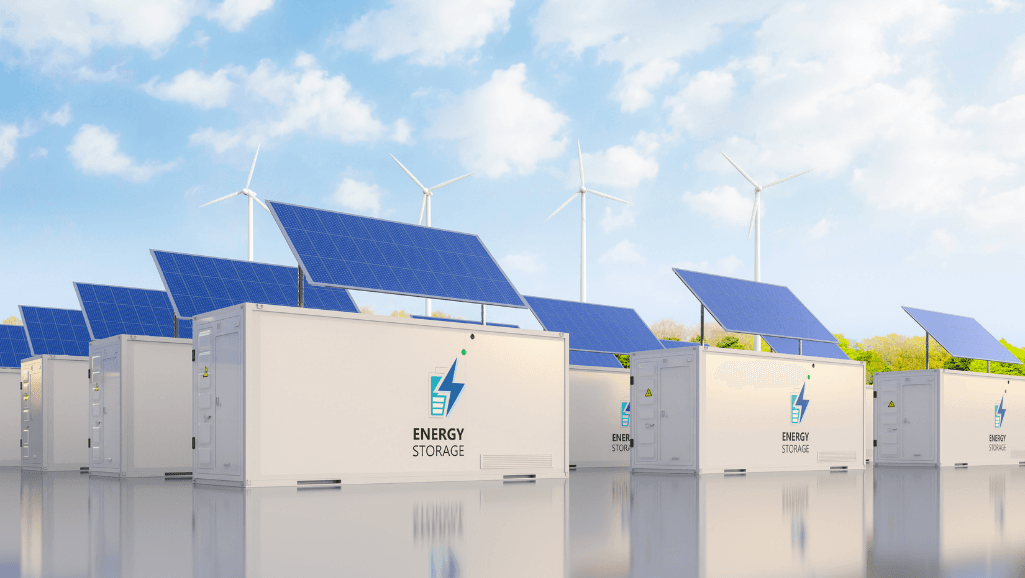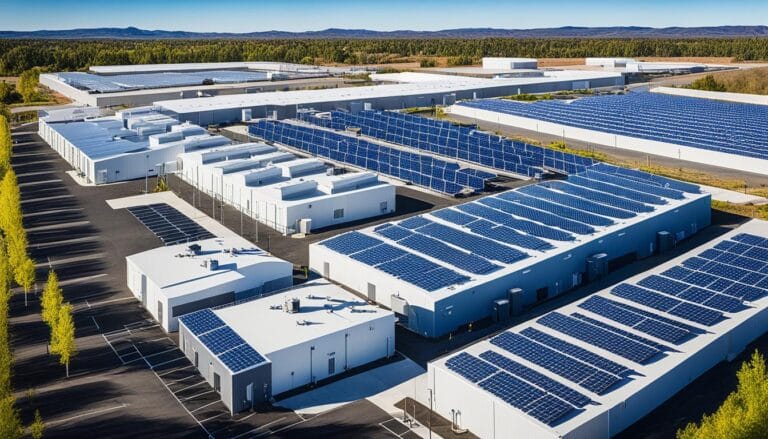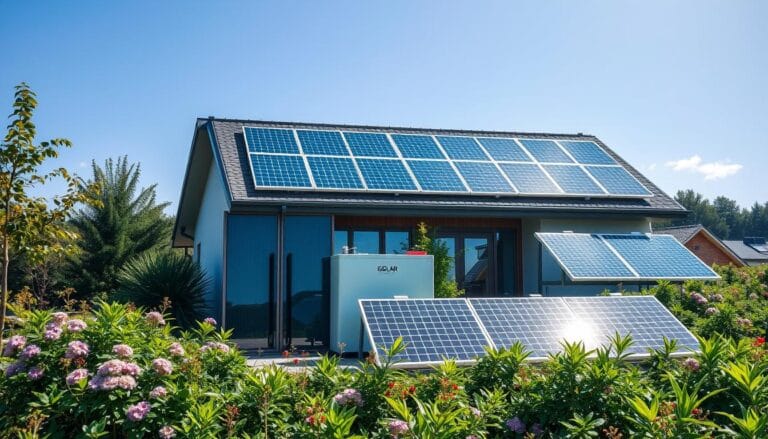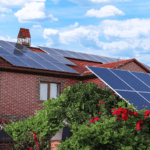Advances in green technology have made solar batteries key for a strong energy storage solution. They are vital for renewable energy systems. Photovoltaic batteries help solve the problem of the sun’s unpredictable nature. This allows for steady and reliable power supply.
Solar batteries let us use solar energy all day, not just when the sun is out. They help match the energy we make with what we need. This is especially important in places like California, where using stored solar energy can save a lot of money.
Solar batteries offer many benefits, like cutting costs and reducing our reliance on the grid. They help us move towards using more renewable energy. This leads to lower bills for consumers and less pollution overall, showing the power of green technology.
Key Takeaways
- Efficient solar energy storage is changing how we use solar power, letting us use it even after the sun goes down.
- Solar batteries help fill the gap between when we make the most energy and when we need it.
- Using these solutions saves money and helps keep the power grid stable.
- The value of solar batteries is clear through programs like Net Billing Tariffs.
- Investing in solar batteries means moving towards using our own energy and reducing harm to the environment.
- Energy storage solutions with solar power are crucial for a sustainable and reliable energy supply.
Solar Batteries: Bridging the Gap Between Energy Production and Consumption
Solar batteries are key in today’s energy world. They help manage the ups and downs of solar power. This makes sure we have enough energy when we need it, making our energy use more independent and green.
The Inherent Intermittency of Solar Power
Solar power depends on daylight, so it changes with the weather and at night. Energy storage systems help by saving extra power for when the sun isn’t shining. This keeps our energy steady and helps the grid stay stable.
Peak Energy Demand and Solar Generation
Energy use goes up in the morning and evening, when the sun isn’t shining as much. Solar batteries store power for these times. This means we use less traditional energy and are kinder to the planet.
Let’s look at different batteries used in energy storage. They help make solar power better and give us more control over our energy:
| Type of Battery | Key Features | Advantages |
|---|---|---|
| Lithium-Ion | High energy density, lightweight, high efficiency | Best suited for high-capacity solar power storage, long lifespan, quick charge/discharge |
| Lead-Acid | Low initial cost, good reliability, highly recyclable | Ideal for smaller solar setups, cost-effective for entry-level systems |
| Flow Batteries | Scalable, efficient energy storage, operates with two electrolyte solutions | Excellent for large-scale energy storage requiring long discharge times |
As we improve eco-friendly battery tech, solar batteries are more vital. They store extra energy for when we need it most. This helps us use energy on our own terms and cuts down on fossil fuels.
Understanding Solar Energy Storage Systems
Solar energy storage systems are key to making power from the sun more reliable and independent. They store extra solar energy for use when the sun isn’t shining. This is a complex field with many technologies working together.
Categories of Solar Energy Storage
There are three main types of solar energy storage: battery, thermal, and mechanical. Each type has its own benefits and uses. Battery storage, often using lithium-ion batteries, is popular for homes because it’s efficient and can grow with your needs. Thermal storage saves heat in the sun to use later, and mechanical storage uses big methods like pumped hydro for large projects.
Lithium-Ion Dominance in the Market
Lithium-ion batteries lead in renewable energy storage at home. They’re the same tech in smartphones and laptops but for bigger use in homes. They can safely use up to 95% of their power, making them great for long periods. This reduces waste and boosts green energy solutions.
Technology Evolution and Expected Growth
The energy storage technology is changing fast. By 2025, the U.S. market could hit nearly 7.5 GW a year. This growth comes from new battery chemistry, better software, and policies like the solar ITC extension.
| Energy Storage Type | Cost per kWh | Typical Use Case |
|---|---|---|
| Compressed Air | $105 | Large-Scale Mechanical Storage |
| Pumped Hydro | $165 | Large-Scale Mechanical Storage |
| Lithium-Ion Batteries | $12,000-$22,000 per system | Residential Solar Storage |
Understanding solar energy storage, especially lithium-ion batteries, is key for those looking at renewable energy. The market is growing and getting better with new tech. This makes solar energy storage more available and affordable for more people.
Advantages of Integrating Storage with Solar Panels
Combining solar panels with solar battery storage brings many benefits. It’s key for a greener and energy-free future. This mix offers both economic and environmental perks, vital in the shift to renewable energy.
Balancing Electricity Loads and Reducing Grid Reliance
Solar battery storage helps balance electric loads by managing solar power’s ups and downs. It stores extra energy when the sun shines brightly. Then, it sends power when the sun is low or demand is high, keeping the grid stable.
This approach makes the most of solar energy and cuts down on grid use. It’s a big step towards being energy independent.
Facilitating Energy Resilience in Adverse Conditions
Solar battery storage shines during power outages or bad weather. It keeps the lights on and services running, protecting homes and businesses from power cuts.
Enhancing Energy Independence with Off-Grid Solutions
Off-grid setups with solar chargers and storage offer total energy freedom. They’re perfect for places where grid access is hard or too expensive. Solar batteries let people use solar power well, supporting sustainable living.
Using sustainable energy storage lowers bills and cuts carbon emissions. It meets global energy saving goals. Plus, new solar tech makes solar batteries better, pushing us towards a cleaner energy future.
The Economic Impact of Solar Battery Technology
The growth of solar battery systems changes how we use energy economically and environmentally. Thanks to new tech, solar battery backup systems are getting more popular. This is because they save a lot of money and make energy use more efficient.
Technologies like lithium-sulfur and solid-state batteries are key to this change. They last longer and are better for the planet in renewable energy uses. Now, affordable solar batteries are easier to get because making them costs less. This is thanks to new ideas and making more of them.
Using solar storage helps control electricity bills better. In places where electricity costs a lot, solar battery systems are a big help. Over the last ten years, electricity prices in the U.S. have gone up about 15%. This shows how important solar batteries are for keeping costs stable.
Battery storage helps reduce our reliance on the grid. It stores extra solar power, making us less dependent on traditional power plants. This move is good for the planet and our wallets, as solar battery prices keep falling.
There’s a lot of proof that solar battery backup is a smart choice. Upgrading to solar with storage cuts down the time it takes to pay off the investment. It also lowers the cost of solar batteries. This makes more people and businesses switch to solar, creating jobs and boosting local economies.
In the end, using affordable and efficient solar batteries is key to being energy independent and sustainable. As shown in the economic effects of energy storage, solar battery systems will play a big role in a better energy future.
Components of a Solar Battery System
An effective solar battery storage system has many parts that work together. These parts are key for capturing, changing, and using solar energy well. Let’s look at these important parts and what they do in renewable energy.
Breaking Down Solar Battery Chargers and Inverters
Solar battery chargers and inverters are at the heart of a solar battery system. Chargers make sure batteries charge right, which helps them last longer and work better. For example, the Sol-Ark all-in-one unit does many jobs at once, like inverting, charging, and monitoring.
Enphase’s IQ7 series microinverters are also great. They last a long time, with a 25-year warranty, and change power directly at the panel.
System Design and Storage Capacity
How a solar battery system is designed is key to its success. It needs to match the energy use of a home, the solar power it gets, and the weather. New tech lets these systems manage energy smartly, using algorithms to know when to use solar power and work with the grid.
Long-lasting solar batteries, like those using lithium-ion, are reliable and grow with your needs. They keep power going even when the sun isn’t shining. For example, a 72-cell solar battery system stores more power than a 60-cell one, giving you more energy when you need it.
Now, solar battery systems come with smart features like the Enphase Ensemble package. This package makes managing energy easy and keeps the battery working well. It helps you save money over time and is better for the planet.
The benefits of using these advanced systems are clear. They cut costs and are better for the environment, as shown by the study on solar power.
Popular Solar Battery Choices and Their Features
Lithium solar batteries are now the top pick for home solar setups. They include the Tesla Powerwall and LG Chem RESU. These batteries bring big leaps in storing energy and are made with the planet in mind.
Lithium Solar Batteries and Their Longevity
Lithium-ion batteries like the Tesla Powerwall lead in eco-friendly solar tech. They last a long time and work well. They’re better than old lead-acid batteries and fit today’s need for saving energy and being green. With a 30% tax credit until 2032, they save money and help the environment.
The Rise of Green Technology in Energy Storage
Green tech is pushing solar batteries forward. The Sonnen Eco uses lithium solar tech’s best points—low upkeep, long life, and staying stable in heat. Switching from old lead-acid batteries to newer, better ones changes how we see energy storage. It’s now seen as key for the planet and working well.
- Lithium-ion batteries are safer and need little upkeep, making them great for those who care about safety.
- Nickel-cadmium batteries work well in tough heat but are being replaced by greener, better options.
- Flow batteries last up to 30 years and are safe for the planet, showing the future of storing energy.
As tech gets better, more people will choose eco-friendly solar batteries. This will change how we use renewable energy storage.
Innovations in Energy Storage Technology
Advances in energy storage technology are changing how we handle and use renewable energy. The need for eco-friendly batteries is growing, leading to new breakthroughs in solar energy storage solutions.
Next-Generation Batteries and Sustainable Alternatives
New battery technologies are moving towards being more sustainable and efficient. Lithium Iron Phosphate (LFP) batteries are becoming popular for their safety and long life. They fit well with the goal of using eco-friendly batteries.
Silicon anodes are also improving, making batteries work better. This is helping to make sustainable power storage more common. Iron flow batteries are being tested for big projects, like a new 1 MW plant by ESS.
Software Tools for Optimizing Storage Solutions
Companies like Stem, Inc. are using AI to make battery use smarter. This helps make solar energy storage solutions work better. The software looks at how people use energy and changes storage plans to be more reliable and save money.
| Technology | Impact | Example |
|---|---|---|
| Lithium Iron Phosphate (LFP) | Increased safety and lifespan | Widely used in residential and commercial storage solutions |
| Silicon Anode | Enhanced performance | Improving efficiency in newer battery models |
| Iron Flow Batteries | Suitable for utility-scale storage | ESS’s new 1 MW storage facility |
This shows how energy storage technology is moving towards better, bigger, and sustainable power storage options.
Challenges Facing Solar Battery Implementation
Switching to sustainable energy brings new challenges, especially with solar battery backup systems. High upfront costs and different technologies are big obstacles. For instance, a full solar power backup system can cost up to $10,000, making it hard for homeowners who already pay for solar panels.
Costs are just one issue. Laws and regulations are not always clear, making it hard to use solar battery backup systems everywhere. There are many types of batteries, like old lead-acid and new Lithium-ion, which can confuse people and make it harder to set them up.
How much sun an area gets affects solar power too. Places with less sun need special systems and smart tech to store more energy. For example, areas with less sun do better with solar panels that move to catch more sun and AI software to use energy better.
| Technology | Cost Range | Efficiency | Annual Growth |
|---|---|---|---|
| Old Lead-Acid Battery | $5,000 – $10,000 | Upper 30s % | Declining |
| Modern Lithium-ion/VRLA | $8,500 – $10,000 | Mid 40s % | Growing |
| Multi-junction PV Cells | $10,500+ | Over 45% | Emerging Technology |
New tech like bi-facial and multi-junction PV solar panels make solar power even better, over 45% efficient. This means we need better batteries to handle more power. It’s a challenge for battery makers to keep up with solar tech changes.
Overcoming these hurdles is key to making renewable energy storage work better and spread it more widely. We need everyone – policymakers, makers, and users – to work together. They must support new tech and make solar battery backup systems easier and more useful for everyone.
Case Studies: Successful Adoption of Solar Batteries
The move to sustainable energy storage has made big strides, especially in homes and businesses. These examples show how solar batteries work well and how they help with off-grid power and better energy storage.
Residential Success Stories of Sustainable Energy Storage
Solar batteries like Tesla Powerwall and LG Chem RESU have changed life at home. They give homeowners energy security and freedom, especially when the power goes out. They also help cut down on using the grid.
Homeowners use net-metering to sell extra energy back to the grid. This makes their solar power systems more efficient and saves money. It shows how solar batteries are useful every day by saving on costs during peak times.
Commercial and Utility-Scale Storage Breakthroughs
Big buildings and utilities use solar batteries to handle high energy needs and add more renewable energy. A study found that smart charging helps reduce strain on the grid during busy times. This makes energy systems stronger and more reliable.
Big-scale solar batteries help keep the grid stable by controlling energy flow and reducing peak usage. This is key for keeping things running smoothly and meeting goals for saving money and the environment.
- Lithium-ion batteries lead the market with high efficiency, like SolarEdge Home Battery’s 94.5% and Tesla Powerwall’s 90%.
- Even though they cost a lot at first, prices are dropping and technology is getting better, making solar batteries more affordable.
- Working with smart grid tech is a big step forward for better energy use and management in different places.
Putting these solutions into action in homes and businesses boosts energy efficiency. It also takes solar battery storage to new levels of innovation and sustainability.
Conclusion
Solar batteries are changing how we manage energy and think about sustainability. They are key to fighting climate change. With their growing efficiency and lower costs, they help us use eco-friendly power storage.
These batteries let us use solar power even when the sun isn’t shining. They help us use less traditional power and make our energy use smoother. This is good for our planet and our wallets.
Companies like Sunlight Solar Inc. are making it easier and cheaper to use solar batteries. They offer services that help people save money and gain energy freedom. Governments are also supporting this move with incentives.
Even though there are challenges, like storage capacity and battery production’s environmental impact, progress is being made. There are many types of batteries available, each with its own benefits. Factors like lifespan and efficiency matter when choosing the right one.
Looking forward, the growth of green technology, like solar batteries, is crucial. It’s helping create a future with reliable, affordable, and eco-friendly energy. This is key for a sustainable world.






















